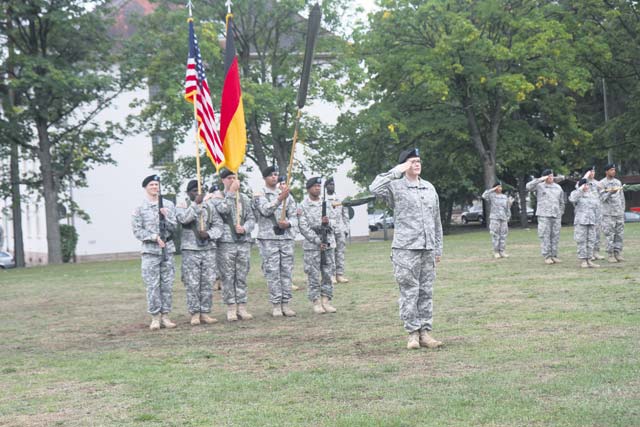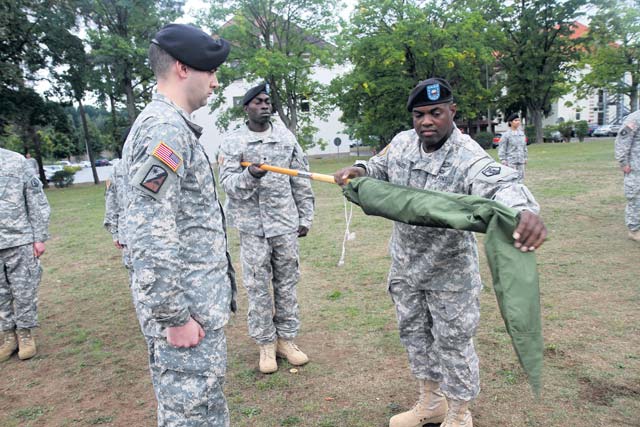
The Army Reserve’s 7th Civil Support Command activated three units during a Sunday afternoon ceremony.
With intermittent rain drizzling on the parade field, leaders from the 446th Transportation Battalion, its Headquarters and Headquarters Detachment and the 341st Movement Control Team uncased the units’ colors.
The 446th, also called a Movement Control Battalion, took command of the 7th CSC’s four Movement Control Teams. They include the newly created 341st, the 793rd, 1172nd and 1177th.
The battalion’s Army Reserve mission supports the total force and NATO allies and partners. It will provide movement support across Europe, facilitating the 21st Theater Sustainment Command.
Movement control is the planning, routing, scheduling, controlling, coordinating and maintaining in-transit visibility of personnel, units, equipment and supplies. The unit provides movement control for various types of missions, including ongoing support to Operation Atlantic Resolve.
The ceremony marked the beginning of the unit’s legacy in Germany, said Lt. Col. Aaron Justice, commander of the 446th.
In the past, U.S. Army Europe had a very robust movement control capability, he said. Over time, many of those units left making the 446th’s capabilities even more essential in today’s European environment.
USAREUR has been very busy, and the 446th will be a key element to continue that pace, said Col. Miguel Castellanos, commander of the 361st Civil Affairs Brigade, which will be the higher headquarters for the 446th.
Castellanos said, “this timing is critical,” because the unit is needed.
Even so, the battalion already has been working hard with only a skeleton crew, Castellanos said.
“You’ve got a great crew that’s in place,” he said.
As the units were getting ready to activate, 7th CSC MCTs have been busy, Justice said. They supported Operation Atlantic Resolve North, Operation Atlantic Resolve South and Western Accord 15.
“You have done a great job in the last year,” Justice told his troops.
Preparations are underway for the unit to expand its role next year, including other exercises and operations.
The 446th’s location in Kaiserslautern will help it be integrated with the 361st, the 7th CSC and the 21st TSC, Castellanos said.
He also discussed how the unit fits into USAREUR’s five pillars of Strong Europe which includes empowering junior leaders, the National Guard and Reserve component, allies and partners, regionally aligned forces and active engagement.
“The 446th is already conducting active engagement with its subordinate unit’s missions in the Baltics and elsewhere,” Castellanos said. “That’s the active engagement we’re looking for.”
One of the keys to maintaining mission readiness is to empower junior leaders, Castellanos added. Senior leaders must empower junior leaders to take initiative, especially during a mission where they will have limited guidance.
Leaders must empower, motivate, challenge and encourage, Castellanos said.
“That’s an important part of being a leader,” he said.
The newly-activated MCB traces its lineage back to World War II. It was constituted in 1942 as Headquarters and Headquarters Detach-ment, 2nd Battalion, 467th Quartermaster Truck Reg-iment and activated Dec. 10, 1942, at Fort Custer, Mich.
The unit was reorganized and renamed multiple times before being in-activated Dec. 24, 1965, in Baltimore, Md.
It participated in the Normandy, Northern France and Central Europe campaigns during World War II.



